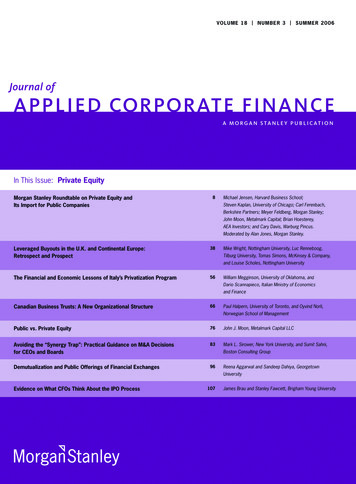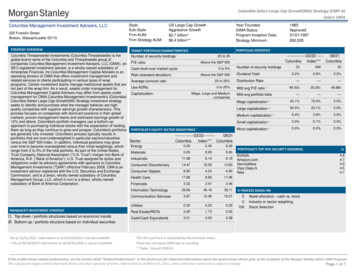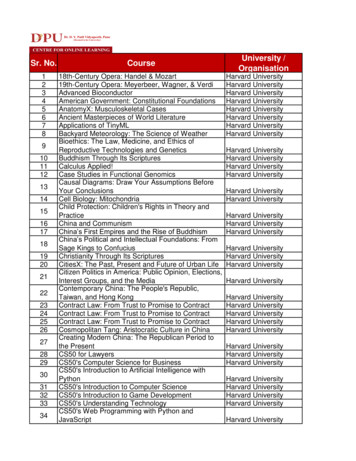
Transcription
Public vs. Private Equity*by John J. Moon, Metalmark Capital LLCome executives may dismiss private equity as“expensive” capital while viewing public equityas a relatively “cheap” source of funds. Sincereturns on private equity have been higher thanthe returns earned by public equity investors, so the theorygoes, the cost of private equity must be greater. But thislogic misses the point. For both private companies considering whether to go public and public companies consideringwhether to go private (and all other companies in between),there is much more to making sound equity-raising decisions than simply comparing investor returns. Who providesequity capital to a company is as important as how muchequity is raised. Both decisions can have significant ramifications for firm value.As discussed in this article, private equity and publicownership represent very different packages of costs andbenefits. When you do the cost-benefit analysis, publicequity may not turn out to be as cheap as it seems. And, insome cases, the benefits of private equity may prevail. Onlyby recognizing the costs and benefits of each can companiesmake the value-maximizing choice.SPublic EquityThe private equity market is dwarfed by the public equitymarkets. As of January 2006, the NYSE reported that U.S.publicly traded companies (listed on all exchanges) represented approximately 18 trillion in total equity value. Bycontrast, the total equity value comprising the private equitymarket is measured in the hundreds of billions of dollars.Textbook finance theory characterizes the public marketsas highly efficient and very liquid. The public market represents the superset of all theoretically possible investors, andcompanies that are large enough to raise equity in thatmarket are believed to be able to do so smoothly, at almostany time, and at a relatively low cost that reflects investors’ability to diversify their portfolios. Such, for instance, arethe underlying assumptions of the Capital Asset PricingModel. And in addition to the benefits of attracting a broad,well-diversified investor base, many executives believethat being public provides a company financial flexibilityand credibility in the eyes of its customers, suppliers, andemployees. What’s more, for private companies, an initialpublic offering can represent an important milestone offinancial success—for the company, its shareholders, andoften the executives themselves.But financially sophisticated executives will recognizethat, for all its attractions, there are real costs to raising capitalin the public market and to being a public company—andthese costs can be substantial. Most executives are awareof the direct costs of raising public equity. The fees paid tounderwriters, auditors, attorneys, and other intermediariestypically run from 3% to 5% of the gross proceeds of anoffering for an already public company, depending on thesize of the issuance among other factors. Compliance andinvestor relations efforts involve additional—and, with theintroduction of Sarbanes-Oxley, growing—costs associatedwith having public shareholders.But as large as these direct costs are, there are potentially much larger costs that are often overlooked. One clueto the source and size of such costs is the negative marketreaction to announcements of seasoned equity offerings.The most widely cited academic study was authored by PaulAsquith and David Mullins from Harvard (at the time).1Their study and others like it find that the announcement of such an offering causes the average (unregulated)company’s stock price to drop by about 3% —and, in somecases, the drop can be as much as 10% or more. While adrop of 3% may not seem like much, unlike the direct costsmentioned previously, this cost affects the value of all thecompany’s shares.To illustrate the potential loss of value, let’s assumethat a company undertakes an equity offering to raiseabout 100 million, which represents 10% of a company’spre-offering market cap of 1 billion. Assume also thatmanagement believes that the pre-announcement value ofthe firm, 1 billion, is also its fair value. In that case, if the* This article draws on the author’s previous article on private equity published by Oil& Gas Investor.1. P. Asquith and D. Mullins, (1986), “Equity Issues and Offering Dilution,” Journal ofFinancial Economics, Vol. 15, pp. 61-89.76Journal of Applied Corporate Finance Volume 18 Number 3A Morgan Stanley Publication Summer 2006
stock price were to drop by 3% on the announcement of theoffering, that drop would represent a 30 million decline inthe equity value of the firm, and that 30 million losswould amount to 30% of the proceeds from the offering!Effectively, a 1 billion company could expect to incurmore than 30 million in total costs to raise 100 million.If this sounds implausible, consider the market reactionto a high-profile equity offering undertaken by AT&Tin 1983. When AT&T announced a 1 billion publicequity offering in February of that year, it experienceda 3.5% drop in its stock price. That drop represented 2 billion in its market capitalization, and thus 200%of the amount to be raised. Nevertheless, the companyproceeded with the offering.In theory—or at least in a world where well-understoodcompanies were always correctly valued and managers couldbe counted on to maximize value—stock prices should notreact negatively to equity offerings. And to the extent theannouncement of an offering is a signal of promising newinvestment opportunities in need of funding, stock pricesmight in fact be expected to go up. Indeed, some researchshows a systematically less negative reaction—and, inindividual cases, a positive reaction—to offerings by highgrowth companies.2 But on average, empirical research hasdemonstrated that the market reaction to equity offeringsis negative.Public investors are skeptical providers of capital, and themore complex the company and its business plan, the moredifficult and expensive it becomes to raise public capital,particularly equity. Hence investment bankers emphasizethe importance of management’s “credibility with investors” and its ability to communicate a “credible story tothe Street”—without which the cost of issuing equity canbe exorbitant. Public investors can be at a material informational disadvantage vis-à-vis the company’s executivesor other insiders, who are seeking to acquire capital at thelowest possible cost. Investors’ natural response to thisdisadvantage is skepticism: If a company is raising equityinstead of raising debt or relying on internally generatedfunds, management may believe the firm is overvalued (or atleast not undervalued). Or worse, the firm may really needthe funds because it is anticipating disappointing earningsfrom its existing businesses.Indeed, investment bankers insist that the publicmarkets can sometimes be “closed” to some companies.As prospects for a company become more uncertain,perhaps resulting from a period of financial hardship or abusiness transformation, public investors may grow waryand demand a meaningful discount to purchase new sharesfrom the company. The company’s willingness to accept alarge discount to execute an offering may itself signal newadverse information about the company (or its managementteam), which in turn will cause a skeptical public to furtherdiscount the value of the company’s shares. For some issuersin severe situations, this downward spiral of confidencecan result in the market “failing.” In other words, there isno price—or at least no price the issuer would accept—atwhich the market is willing to provide new equity.These dynamics can be particularly acute in cyclicalor otherwise volatile industries. Many executives believethat such industries present their most profitable opportunities during economic downturns—think, for example,of organic expansion, acquisitions, or even R&D—whenproject costs are lower and competition for opportunitiesless intense because even public companies find themselvescapital-constrained. These periods are precisely whenthe public markets are likely to be costlier to tap or evenclosed.Therein lies the paradox of public capital: it’s mostreadily available when a company may not need it and leastavailable when it does. Much like credit, it is cheapest whentimes are good and a company already enjoys high cashflow and expensive in downturns, when investment maybe highly attractive but financial flexibility is constrained.In uncertain times, public investors are likely to providecapital reluctantly if at all. If financial flexibility is the keyto capitalizing on opportunities in the long run, publiccapital may come up short.Private EquityThe way in which the private equity market is structuredand operates represents a stark contrast to the public equitymarket. Whether one defines private equity strictly as laterstage investments, which are typically control-orientedtransactions involving mature companies, or includes earlystage investments by venture capital firms as well, privateequity investors firmly believe that they offer a very different proposition from what is offered in the public market.Rather than simply offering capital in exchange for passiveequity interests as traditional public investors do, mostprivate equity investors (rightly or wrongly) fancy themselvesas “adding value” to the companies in which they invest.In contrast to most professional investment vehicles(with hedge funds representing the relatively small butgrowing exception in the public arena), the fortunes ofprivate equity investors are tied directly to the success of their2. See K. Jung, Y. Kim, and R. Stulz, (1996), “Timing, Investment Opportunities, Managerial Discretion, and the Security Issue Decision,” Journal of Financial Economics, 1996,Vol. 42, pp. 159-185Journal of Applied Corporate Finance Volume 18 Number 3A Morgan Stanley Publication Summer 200677
investments and, hence, to the prospects of their portfoliocompanies. Whether it is a venture capital firm providingseed capital to a startup or a private equity firm sponsoringa going-private transaction of a Fortune 500 company, theirfunds are typically structured as limited partnerships wherethe private equity professionals serve as general partner(GP) of the fund. The GP’s compensation is tied directlyto the performance of the fund itself. In addition to beingan investor in the fund itself, typically representing 1% to10% of the total capital committed, the GP is compensatedin two main ways: (1) an annual management fee, typically1%-3% of the fund’s commitments, which is expected tocover much of the ongoing expenses of running the privateequity firm; and (2) a “carried interest” in the fund, typically20% of the gains generated by the fund (usually only if thelimited partners have received a preferential or minimumreturn, typically on the order of 8%-10%), which is sharedamong the partners and often the junior investment professionals of the firm. These funds typically have a finite life of10 or more years, with the first five or six years representingthe investment period during which the committed fundsare expected to be invested.The incentives of the GPs of private equity firms arethus quite different from those of managers of long-onlymutual funds that invest in the equity of public companies.Whereas the carried interest provides powerful incentives toreward success in private equity investing, the vast majorityof public equity is managed in funds solely compensatedwith a fi xed percentage of assets under management,irrespective of returns. Strong performance is expected togrow the asset base and thereby yield larger fees, but thiscorrelation is imperfect at best. And the compensation ofindividual managers, while loosely correlated with fundperformance, is generally not nearly as sensitive to fundperformance as the private equity model.As previously mentioned, the exception in the publicequity sphere is hedge funds, which have a carried interest structure similar to private equity funds. Indeed, thegrowth in the size and influence of hedge funds may beviewed in part as an interesting attempt to bring greaterpay-for-performance into the public investing arena.“Value-Adding” InvestorsRecent academic research on the private equity marketsuggests that at least some investors appear to add value.In contrast to research from public equity funds, including mutual funds and even hedge funds, a recent studyby Steve Kaplan of the University of Chicago and Antoinette Schoar of M.I.T. reported that, over long periods oftime, private equity firms have produced average returnsto investors (net of fees) that are roughly equivalent tothe returns on public equities.3 The study also showed,however, that private equity funds with a proven trackrecord of success were significantly (in a statistical as wellas economic sense) more likely to demonstrate success infuture funds than funds managed by GPs without such atrack record. In other words, the data seem to show that,in contrast to public equity investors and hedge funds,private equity investors demonstrate long-run, sustainabledifferences in ability and performance. Thus, in privateequity, unlike mutual funds, past performance appears tohave some predictive power.This demonstrated difference in the persistence of thereturns of public and private equity investors is not necessarily surprising. Consider the following: imagine two fundmanagers, one who invests strictly in public equity securities and one who invests strictly in private equity. Nowimagine that both adopt a strategy of investing randomly(e.g., making all decisions, including what securities to buy,based on a coin toss). Studies have demonstrated that thepublic fund pursuing such a strategy will have as much difficulty underperforming the market as it will outperformingthe market. The private equity fund will not be so fortunate. Indeed, the very idea of random or indexed investingin private equity is an ill-defined term since the investmentactivities of a private equity investor involve much morethan whether to buy or sell, how much, and at what price.Regardless of one’s belief about the degree of efficiency andliquidity of the public market, most agree that private equityfunds operate in a market with a significantly lower degreeof efficiency and liquidity. The skills necessary to succeedin the private equity market are arguably broader than thoserequired to invest in public companies; and, as Kaplan andSchoar’s results suggest, the variation in such skills amongprivate equity firms appears to be much more pronounced.Some corporate executives appear to recognize that notall private equity investors are alike. A study by David Hsuof the University of Pennsylvania reports that early-stagecompanies with multiple offers by venture capital firmsdon’t always choose investors based solely on the highestvaluation.4 Rather, the companies select venture capitalinvestors based on reputation and other considerations. Myown doctoral research at Harvard found that even publiccompanies, when issuing private equity securities (oftencalled “PIPES” for Private Investment in Public EquitySecurities), issued the securities to private equity investorsat a discount to the prevailing market price, thereby effectively compensating them for some value-adding skill or3. S. Kaplan and A. Schoar, (2005), “Private Equity Performance: Returns, Persistenceand Capital Flows,” Journal of Finance, Vol. 60, pp. 1791-1823.4. D. Hsu, (2004), “Why Do Entrepreneurs Pay for Venture Capital Affiliation?”, Journalof Finance, Vol. 59, pp. 1805-1844.78Journal of Applied Corporate Finance Volume 18 Number 3A Morgan Stanley Publication Summer 2006
service. This discount is quite different from the standardcorporate practice of issuing similar equity securities toother corporate (typically referred to as “strategic”) investors at a premium. Perhaps even more surprising, thesePIPES transactions were associated with a positive stockprice reaction (of about 10%, on average), in contrast tothe negative reaction to the typical follow-on public equityoffering mentioned earlier.Among professional private equity investors themselves,there is a very strong belief that at least some investors (agroup which typically includes themselves) have the ability toadd value to their portfolio companies. Private equity investors view themselves as more than just good analysts who“buy low and sell high”—and even more than hedge fundinvestors who buy underappreciated companies and shortovervalued ones. Private equity investors view themselves asactive investors who contribute complementary skills to themanagement teams and companies they sponsor. The bestprivate equity investors are strategic partners with management in the value-creation process.This difference can often make private equity capitalfrom a professional source a superior choice for companies,even public companies, considering the range of capitalraising alternatives from various sources. Here are someof the ways in which professional private equity investorsbelieve they add value:Liquidity/availability regardless of market conditions. In contrast to high-net-worth individuals (so-called“angels” in the VC community) or even corporate investment fund affiliates, professional private equity funds aretypically limited partnerships composed of highly creditworthy investors (each an “LP”)—e.g., pension funds,endowments and high-net-worth individuals—who havelegally committed to provide funding upon some shortnotice period (typically measured in days) irrespective ofmarket conditions. Therefore, while these limited partnersof a fund hold a highly illiquid investment when they investin private equity, their pooled (rather illiquid) LP commitments are precisely what provide the availability of privateequity capital in difficult industry and market conditions.In fact, private equity investors are often contrarian bystrategy, investing more aggressively when public market appealfor an industry is low. At Metalmark Capital, for example, ourexperience has been that providing liquidity to companies inout-of-favor industries experiencing financial dislocation hasbeen a particularly effective investment strategy.An information-based model of investing. Whereaspublic offerings are undertaken through an SEC registration process and marketed broadly to the universe ofpotential investors who evaluate only publicly availableinformation, the private equity process begins by targetinga small group of investors or sometimes even a single investor. These potential candidates are often selected by anJournal of Applied Corporate Finance Volume 18 Number 3investment banker intermediary or sometimes directly bythe management team itself. The choices are made basedon the industry and financial expertise of the potentialprivate equity partners and the likelihood that they willbe able to understand the company’s operating plan andspecific business issues (and be favorably inclined towardmaking an investment). This small group of potentialinvestors is afforded significantly more information thanwhat is disclosed in an SEC filing.In the private equity arena, the very notion of publiclyavailable information is not a well-defined idea. By its verynature, private equity investing requires extensive interactionwith the executives of any company they are evaluating (inaddition to other contacts who are knowledgeable about thebusiness and industry in which the company operates). Thisprocess always involves due diligence of a business, financial,and legal nature. The process begins with negotiating andexecuting a confidentiality agreement that will govern notonly the use of the information granted to the potential investors but may include other legal issues such as restrictions onsolicitation of employees or standstill agreements that restricttrading in the company’s securities, including any public affiliates. General business and industry-specific due diligence isquite comprehensive, often reviewing with a more discriminating eye information that has already been produced bythird-party evaluators on behalf of the company.For example, a financial review undertaken in a socalled “quality of earnings” report by independent auditorshired by the private equity investor is standard practiceeven when SEC-quality audited financials exist. Andthe due diligence process is often tailored to a specificindustry. In the financial services industry, third-partyvaluation firms are often brought in to evaluate portfoliosof financial assets even when auditors have been responsible for regularly testing asset valuations. In the oil & gasindustry, private equity investors will sponsor independent reserve evaluations that seemingly duplicate workthat has already been provided by the company’s internal or third-party reservoir engineers. The due diligenceprocess calls for critical examination of every piece ofinformation that involves any subjective judgments thatmay materially impact the valuation of the company.Business experience and industry knowledge play keyroles in the private equity investor’s judgments as to whatquestions to ask and how the answers should influencevaluation and negotiations. The ability to negotiate thiscomplex process is a critical element of the ultimate successof a professional private equity firm.While this process may seem burdensome, the rewardsare clear for both investor and management team. Theinvestors are better informed and therefore more confidentin committing capital; a well-informed investor is a willinginvestor. Even in the public company context, the rigorousA Morgan Stanley Publication Summer 200679
due diligence by experienced and reputable private equityinvestors serves as a positive signal to outside investors, whogain comfort from the due diligence process without necessarily being privy to its details. To the management teamthat can credibly communicate its vision, it can be the difference between a successful capital-raising, which enhancesequity value for existing investors (and management), anda highly dilutive offering. Finally, as informed investors,private equity investors are better able to recognize andreward management performance, even in difficult industryconditions, and to serve as champions of the managementteams they sponsor.Greater incentives for management. The due diligenceallows for a candid discussion of the business plan. As a keypart of the investment process, incentive plans are structured or enhanced to provide significant sharing of thevalue to be created by the management team. Alignment ofmanagement and shareholder interests through significantpay-for-performance plans is fundamental to the professional private equity investor’s investment philosophy.These management plans offer significantly greateropportunity for wealth creation than the compensation planof the typical public company, and the link between payand performance is also significantly greater. Private equitygain-sharing arrangements can also be considerably moreflexible. For example, plans can and often are structured toprovide additional incentives for exceptional performanceby a management team or, under certain circumstances,to deliver returns that are taxed as long-term capital gainsas opposed to ordinary income. In my experience, discussions over incentive compensation prove far more pleasant,interactive, and productive than management teams seemto expect based on their prior corporate experience. It isoften a great way for the private equity investor to establishgoodwill and get the working relationship with the management team off to a positive start.We don’t view these negotiations as zero-sum games—and clearly they are not. Our approach is to create plansthat align management’s incentives with investors’ in sucha way that our success relies on management earning asubstantial, and often life-changing, payout for themselves.After the negotiations are concluded, we will all be hoping,and working together, for these life-changing outcomes forthe executives—and the higher the payoffs the better—since the payoffs from these plans are always tied to theactual amount of value created and delivered to the investors. Indeed, it would be inconceivable for us to undertakea transaction where the management team is not given thesehigh-powered incentives. These incentive plans are essentialto facilitating a frank and open dialogue between manage-ment and investors, and they serve as the foundation foreffective corporate governance.Superior governance structure. Large public investors, including most hedge fund investors, generally avoidboard membership because it makes an investor an insiderunder SEC regulations. This insider status restricts theirability to trade shares freely, a status that is problematic forthe public investor who puts a high premium on liquidity.Most public investors view selling out of their investment astheir only practical response to dissatisfaction with a particular company’s performance.By contrast, private equity investors actively seek outboard representation. Indeed, the essence of the privateequity model is better-informed investors interacting withmore highly motivated executives in a closer workingrelationship with more open discussion at the board level.In monitoring investments, private equity investors workwith CEOs, effectively serving various capacities that rangefrom executive coach to consultant to investment banker,providing ongoing advice, analysis, and, when necessary,additional capital. The interaction of private equity investorswith management extends beyond periodic board meetingsto frequent ad hoc conversations about strategic ideas orways to build the company’s network of relationships andmanagerial capital, often leveraging the investors’ proprietary network of business relationships and experience.In contrast, for the reasons mentioned above, publicboards are usually not represented by key investors andgenerally have more members, which can create a tendencytoward bureaucratic behavior. While it is not uncommonfor such board members to hold stock or options in thecompanies they serve, such interests are rarely comparableto the economic stakes of the private equity investors whoserve on the boards of their portfolio companies.Smaller boards can produce less politics and moreefficient decision-making. This view is supported by researchby David Yermack of New York University that showsan inverse correlation between firm value and board size,even boards that are small by public-company standards.5Yermack reports that the reduction in firm value associatedwith doubling board size from six to 12 members is aboutthe same as the drop in value that accompanies anotherdoubling of board size from 12 to 24. The median board inhis sample of public companies consisted of 12 members, anumber that would be regarded as quite large for a privateequity-sponsored company.Complementary business skills. While private equityinvestors are quite careful not to micromanage their portfolio companies and try to limit their role to active boardparticipation, there are times when it may be appropriate5. D. Yermack, (1996), “Higher Market Valuation of Companies with a Small Board ofDirectors,” Journal of Financial Economics, Vol. 40, pp. 185-212.80Journal of Applied Corporate Finance Volume 18 Number 3A Morgan Stanley Publication Summer 2006
Case Studyeveral years ago, when the public markets wereSabsorbing the effects of the Enron scandal and thesubsequent failure of several large energy companies, weat Morgan Stanley Capital Partners6 were involved in aprocess to acquire the oil and gas subsidiary of a utilitythat was undergoing its own “post-Enron” restructuring.The underlying oil and gas assets of the business werequite valuable, according to independent reserve analysis. But, as a result of a prior effort to provide liquidityto its parent company, the oil and gas subsidiary hadsold forward much of its expected production for severalyears to a third party for an upfront cash payment thatwas then paid to the parent as a dividend.This transaction resulted in a business that, despitegood long-term prospects, faced the prospect of negativecash flows for several years until the delivery obligationsunder the forward sale agreement were met and thecompany could again earn cash for its oil and gas production. As part of this process, the parent had entered intoseveral arrangements to support the subsidiary’s crediton behalf of the counterparty to the forward sale, including parent guarantees and the posting of surety bonds.The negative cash flows and the practical challenges ofunwinding the forward sale or otherwise restructuring the business, when combined with the out-of-favornature of the industry, made an initial public offering atan attractive valuation challenging if not impossible.Market observers thus believed that this fundamentally sound business was more likely to fetch a handsomeprice for its parent through a strategic sale to anotherindustry buyer that could see through the credit complexities and short-term negative cash flows. But shortly intothe divestiture process, rumors began to surface that thelogical industry buyers for the business had little interestdue to the negative cash flows and complexity of the financial arrangements. According to investment bankers, thestrategic buyers believed that acquiring a business burdenedby a complex and volatile financial contract and the result-ing negative cash flows would be difficult to explain to analready skeptical public market—one that was still reelingfrom the failure of Enron and the distress of other energycompanies with complex financial arrangements.Fortunately for us, two years earlier we had supportedthe former management team of the target business in astart-up oil and gas business, and our portfol
equity may not turn out to be as cheap as it seems. And, in some cases, the benefi ts of private equity may prevail. Only by recognizing the costs and benefi ts of each can companies make the value-maximizing choice. Public Equity The private equity market is dwarfed by the public equity markets. As of January 2006, the NYSE reported that U.S.











